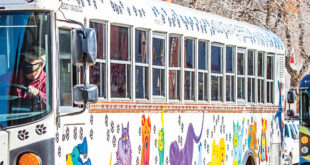Keeping street trash out of the wetlands
By Mark Reaman
The Crested Butte town council gave a thumbs up to the 2023-24 Snow and Ice Control Operations Plan at the October 16 council meeting. Aside from directing staff to cut back on the number of times snowbanks are removed on Elk Avenue over the winter, the plan also addresses concerns with polluting the wetlands east of the town gravel pit where tons of snow are stored and puts some restrictions on who might be eligible for the town’s informal Snow Removal Assistance program.
That assistance program started as a way to help elderly or infirm residences remove snow from their driveways, especially the berms caused by snowplowing, when they had trouble doing it themselves. Crested Butte Public Works director Shea Earley said it was basically an informal small-town courtesy that has grown substantially and was significantly impacting his snow removal crew. He said not so many winters ago there were a few people that used the service, but word spread, and the number of requests has shot up from fewer than 10 to close to 30 last winter. He asked council to okay formal criteria determining eligibility.
“Staff feels that a significant portion of the new requests are from members of the community that are 65 years or older, many of whom may have the financial means to contract with a snow removal company to manage snow berms at the front of driveways,” Earley informed the council in a memo.
At Earley’s suggestion, council agreed that those receiving the town service should live in a single-family residence, have a certified medical need or disability and show that they cannot afford a private snow removal service by demonstrating they receive some sort of public financial aid like being part of the Colorado Low Energy Assistance Program.
Staff will soon contact those that have used the service in the past and make them aware of the new qualifications.
Gravel Pit wetland mitigations
Some council members last spring expressed concern with the amount of trash seen in the snow storage piles at the town gravel pit, specifically in the piles pushed into the adjacent wetland. Given the lack of town snow storage areas available, a council committee admitted that in big snow years, the wetlands might be needed for snow storage. They suggested considering the use of some roadways to store snow where adjacent property would not be affected. The primary spot determined as a possibility was the 400 Block of Red Lady Avenue, but Earley said he wanted to further analyze what impact it would have on the road itself.
As for the primary snow storage area at the town Gravel Pit, the council agreed to rent a bulldozer for the winter between December 1 and April 30. The staff would use the bulldozer to build and push snow piles in a way that would facilitate the most efficient use of the gravel pit and avoid having to push snow into the wetlands. That pilot project is estimated to cost $50,000. Earley said Crested Butte snow removal normally costs the town about $250,000 in a light winter.
“We’re hopeful the dozer idea works but we want to see it before committing to buy a used dozer,” he said. “Ideally this allows us to not go into the wetlands at all.”
Mayor Ian Billick suggested perhaps placing a tarp on top of the wetlands that would let melting snow percolate into the wetlands but catch the street trash and rocks that polluted the wetland in the spring.
Earley said that might work and he was willing to try the idea in a small test patch this winter.
Climate mitigation
Earley outlined some of the climate impacts of the town’s snow removal program. He said a typical snow removal day for the town produces approximately 1,425 kg of CO2. The removal of snowbanks on Elk results in just more than half that amount.
He said the town has acquired two hybrid loaders and expects to purchase another in 2024. “To date, we have seen an approximate 50% reduction in GHG (greenhouse gas) emissions and fuel consumption with the implementation of hybrid loaders,” he reported in the memo. He said the town anticipates purchasing an electric dump truck starting in 2025.
The three-inch rule
In response to council questions on why the town starts plowing at the three-inch snowfall threshold, Earley said it was to keep the snowpack down. He said the goal is to keep the bus and emergency routes in town clear of snow and have no more than a six-inch snowpack on the other streets. “Peeling the pack is very labor intensive and a big snowpack can result in a major problem as we have seen in the past,” he said.
The town starts to clear the sidewalks of snow after one inch of snow accumulation. The accumulation is measured on a camera at the public works yard.
 The Crested Butte News Serving the Gunnison Valley since 1999
The Crested Butte News Serving the Gunnison Valley since 1999


